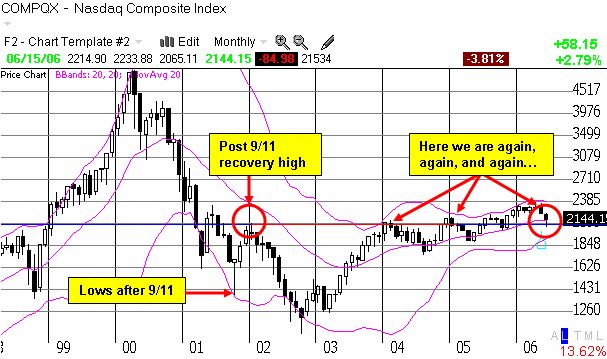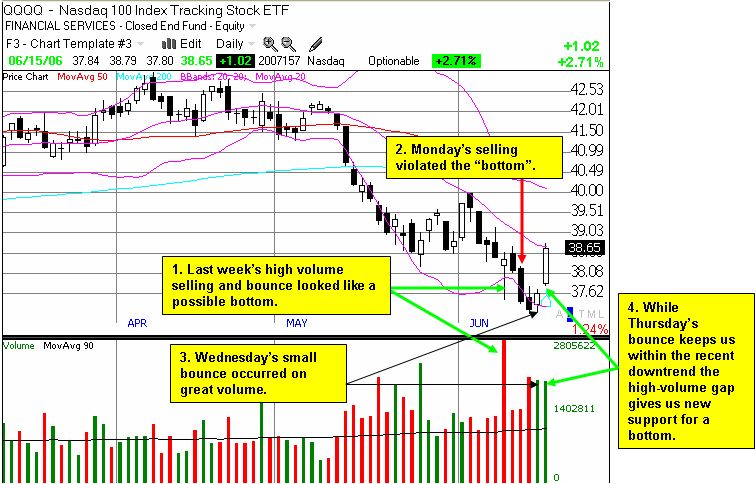Just as we suspected, we got a big rally on Thursday. The sellers finally took a day off. A big day off. The market gapped up and never looked back. Thursday's exuberance was the polar opposite of Monday's despair where the sellers gradually ground the market down to new lows for the year. Last week's apparent capitulation move was generally violated, the bears were howling, and the bulls had to start wondering how low the next leg down would take us. Fast forward to Thursday night where the bulls are no doubt celebrating a major victory and giddilyanticipating making up for lost time.
But wait a second? What are we so happy about? What are we looking forward to? In the last missive, I suggested that the coming rally would happen just because the sellers had finally spent themselves. No capitulation. Just nothing but the kitchen sink and a few dirty spoons left to sell! So, if you know me, you guessed what I will next say. There is nothing new under the sun. Just the market's changing moods. I will reiterate for emphasis: this week's inflation numbers were just as bad, and maybe worse, than May's. While I think the large correction in commodity prices and the continued meltdown in housing will lead to lower inflation pressures in the future, I think it is too early for the market to make serious bets on that....especially with the Fed vigorously trying to convince that it is on the inflation warpath. I will be generous and call Thursday a relief rally reversing Monday's over-reaction in anticipation of horrific inflation numbers. So now what? The S&P 500 rallied right toward its 200 day moving average. It was a historic 2.1% day that in one swift move brought the index right to bear-market resistance. This is less than desirable because the market cannot build a base from which to mount this important attack. Instead, there are a lot of people sitting on fast gains, and even more people with a fresh opportunity to sell at levels they missed on the way down (like last Friday or Monday morning!). A battle of sorts awaits the market and the scales still weigh on the bearish side. A break above the 200 DMA resistance should bring a wave of new buyers convinced the correction is coming to an end.
Although I am skeptical as we face down near-term technical resistance, I really like the bottom (innocent until proven guilty) that formed on the QQQQs. First, notice that, the post 9/11 recovery highs still tug on these markets. The NASDAQ formed this latest bottom right at the highs achieved at the end of 2001 and beginning of 2002. Imagine that. 4 1/2 years later and we are still getting nowhere. I have referenced this magnetic force during many of the market's repeat visits.

Here is a daily chart of the QQQQs with notes featuring what brings me some cheer.

Remember, the key about Wednesday's high-volume but small bounce was in the action in the close. If you had not observed the market's behavior during the day, you would have missed the signs that I thought indicated a decent rally was finally upon us.
Now, what would a Dr. Duru missive be without a reference to the Fed? I have seen claims that the market reacted positivelyto encouraging comments by Fed Chairman Ben Bernanke. I almost fell out of my seat. How could that be? The Fed has become our enemy, not our friend, right?!? Could it be that the Fed is smacking us upside the head with one hand, and scratching our back with the other? You know me. I had to read this for myself. Bernanke spoke to the Economic Club of Chicago about Energy and the Economy. It was pretty good reading. Here is the ONE sentence that is supposed to make us jump for joy: "As yet, these [inflation] expectations measures have remained within the ranges in which they have fluctuated in recent years and inflation compensation implied by yields on government debt has fallen back somewhat in the past month." Now here is the full context in which that one happy sentence appeared:
"Since about 1980, however, the Federal Reserve and most other central banks have worked hard to bring inflation and expectations of inflation down. An important benefit of these efforts is that the second-round inflation effect of a given increase in energy prices has been much reduced. To the extent that households and business owners expect that the Fed will keep inflation low, firms have both less incentive and less ability to pass on increased energy costs in the form of higher prices, and likewise workers have less incentive to demand compensating increases in their nominal wages.
As I noted in remarks last week, although the rate of pass-through of higher energy and other commodity prices to core consumer price inflation appears to have remained relatively low in the current episode--reflecting the inflation-fighting credibility built by the Fed in recent decades the cumulative increases in energy and commodity prices have been large enough that they could account for some of the recent pickup in core inflation. In addition, some survey-based measures of longer-term inflation expectations have edged up, on net, in recent months, as has the compensation for inflation and inflation risk implied by yields on nominal and inflation-indexed government debt. As yet, these expectations measures have remained within the ranges in which they have fluctuated in recent years and inflation compensation implied by yields on government debt has fallen back somewhat in the past month. Nevertheless, these developments bear watching.
In conclusion, energy prices have moved up considerably since the end of 2002, reflecting supply and demand factors. In the short run, prices are likely to remain high in an environment of strong world economic growth and a limited ability to increase energy supplies. Moreover, prices are likely to be volatile in the near term, given the small margins of excess capacity to produce crude oil or natural gas that traditionally have buffered short-run shifts in supply and demand."
In total, Bernanke is repeating the same message. The economy is strong and the resulting robust consumption of commodities has generated infationary pressures. As long as the Fed can contain the expectations of future inflation, we are all good. The Fed's recent acceleration of anti-inflation rehtoric produced the intended effect of bringing commodity prices down. Thursday's rally serves as ironic proof to the Fed that the market remains resilient and tough enough to absorb some more interest rate hikes. We remain on schedule for more Fed meeting drama in two weeks.
In the meantime, be careful out there!